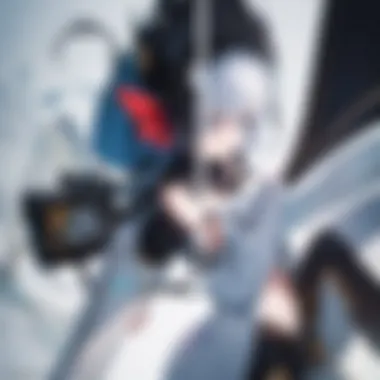The Art and Process of Creating Anime Films


Intro
Anime movie making is more than just drawing vibrant characters and crafting captivating worlds; it's an art form that intricately weaves together storytelling, visuals, and technology. As the curtain rises, what unfolds behind the scenes is a meticulous process involving numerous artists, directors, animators, and voice actors who bring to life the beloved characters and elaborate narratives that have captured the hearts of audiences worldwide. This exploration is not only about the final creation but also about understanding the roots and methodologies that define anime cinema.
In a landscape where anime has transcended cultural boundaries, this article aims to shed light on the intricate journey of anime filmmaking. We will delve into the different stages of production, the essential roles played by key figures in the industry, and how technological advancements have reshaped the narrative capabilities of animation. Furthermore, we will explore the impact anime has made on global cinema, along with reflections on its evolving future.
Through this detailed examination, readers will gain an appreciation not only for the spectacular visuals but also for the profound storytelling that lies at the heart of anime films. Prepare to embark on a journey that reveals the hidden labor of love that shapes the animation we enjoy on screen.
Understanding Anime as a Cultural Phenomenon
Anime is more than just a form of entertainment; it’s a window into the cultural nuances of Japan and a reflection of its societal values. Understanding anime as a cultural phenomenon is crucial for grasping how these films resonate not just within their home country but also with audiences worldwide. The craft of anime movie making blends storytelling, artistry, and technical innovation, revealing aspects of culture that might remain hidden otherwise.
The realm of anime captures a broad range of styles and genres, from action and fantasy to romance and psychological thrillers. Each style carries its own unique flavor, influenced by cultural traditions, folklore, and contemporary societal issues. For instance, a supernatural series may draw inspiration from traditional Japanese spirits or "yokai," whereas a slice-of-life film might reflect modern Japanese family dynamics.
This cultural richness doesn’t solely cater to Japanese audiences. In fact, anime has become a significant cultural export. The various themes presented in anime provide a gateway for international fans to learn more about Japan’s history, customs, and societal challenges. Through narratives that delve into topics like friendship, heroism, and personal growth, viewers find universal connections, bridging gaps between different cultures.
"Anime provides a color palette rich in cultural details that often goes unnoticed by the untrained eye, yet speaks volumes about societal values."
The blending of diverse storytelling techniques keeps the genre alive and ever-evolving which is particularly important as global audiences continue to dive deeper into anime.
Historical Context of Anime
To understand the significance of anime today, one must first delve into its history. Anime's roots trace back to the early 20th century. The first notable work, Katsudō Shashin, dates back to 1907, showcasing early hand-drawn animations. However, it wasn't until the post-World War II era that anime began to gain traction, heavily influenced by the American animation style.
During the 1960s, Osamu Tezuka, often referred to as the "God of Manga," revolutionized the industry with works like Astro Boy. This adaptation of comic books into animated form lay the groundwork for storytelling techniques, character design, and the overall aesthetic we associate with anime today. The '60s were pivotal; the establishment of Toei Animation marked the beginning of a new era, with studios striving to produce films tailored for both children and adults.
As the decades rolled on, anime adapted to the changing media landscape, adopting various artistic styles and exploring more nuanced themes. The '90s saw the explosion of anime festivals around the world, leading to a growing fan base that not only consumed these films but actively participated in their discussions.
In recent years, streaming services have practically staked a claim on anime, making it accessible to a global audience. The historical journey of anime demonstrates its resilience and importance in cultural exchange, showing how animation can reflect and challenge societal norms.
The Global Appeal of Anime
Anime's rise as a global phenomenon is a testament to its adaptability and universal themes. It transcends language barriers through expressive visuals and relatable storylines. Stories set in fantastical worlds often include characters growing through challenges that anyone, regardless of their background, might face.
One significant factor contributing to the global appeal of anime is its variety. Fans can explore different genres tailored to numerous tastes, from the action-packed Attack on Titan to the heartfelt Your Name. This diversity allows for a wide range of interpretations and emotional engagement, fostering a sense of community among fans across continents.
Social media platforms like Reddit and Facebook have amplified this sense of belonging, where thousands unite over shared interests. Discussions range from thematic explorations to production techniques, allowing fans to connect on different levels. Conventions globally further strengthen this community, showcasing fan art, animation, and cosplay.
Moreover, cultural exchanges are seen in how anime influences Western media; various series have inspired live-action adaptations, animations, and even video games. This cross-pollination enriches both Eastern and Western storytelling traditions, underscoring the potential for cultural products to resonate across vast geographical and cultural landscapes.
The understanding of anime as a cultural phenomenon delves into its rich history and its ability to unite diverse audiences. Analyzing such aspects not only enhances our appreciation of anime films but also highlights their impact on global culture.
The Essential Elements of an Anime Film
In the intricate craft of anime filmmaking, the essential elements serve as the backbone of storytelling. These elements play a critical role in defining the narrative, influencing viewer engagement, and shaping audience perceptions. Whether through character depth, artistic style, or thematic richness, each element weaves a narrative tapestry that resonates with fans worldwide.
Storytelling Techniques
Character Development
Character development stands at the forefront of anime storytelling. It's more than just crafting protagonists and antagonists; it's about layering depth and complexity into their personalities. Engaging backgrounds, desires, and flaws transform characters into relatable figures, making viewers invest emotionally in their journeys. A prime aspect of character development is the character arc, which showcases their evolution throughout the story. This dynamic progression reflects growth or regression, lending a dose of realism to even the wildest plots.
The key characteristic of character development lies in its ability to evoke empathy. Audiences find themselves rooting for characters who mirror their struggles, making it a popular aspect of the genre. A well-developed character can carry the emotional weight of a story, leading to unforgettable moments that linger long after the credits roll. However, if not done right, this same element can lead to predictable tropes, also called "character clichés." Thus, balance is crucial here.
Plot Structure
Plot structure dictates the architecture of a film's narrative. It determines how tension unfolds and how the story escalates, ultimately guiding viewers through a rollercoaster of emotions. The classic three-act structure is a common approach, laying the foundation for exposition, conflict, and resolution. Each act serves a distinct purpose, keeping viewers enraptured and engaged.
A significant aspect of plot structure is pacing. Well-timed reveals and cliffhangers can maintain anticipation, while premature resolutions may leave viewers wanting more. This is essential for a successful anime film, where viewer satisfaction hinges on plot dynamics. An uneven structure can feel jarring, leaving the audience perplexed. Therefore, it is vital to engineer plot points with careful consideration.
Theme Exploration
Theme exploration dives into the core messages a film conveys. Themes like friendship, identity, and existentialism resonate deeply with audiences for their universality. They offer a framework for exploring complex issues and moral dilemmas through a lens that’s approachable yet profound.
The key characteristic of effective theme exploration is its ability to spark dialogue among viewers. Just as a painter uses color to express feelings, themes contribute to the emotional palette of a story. This makes it not just a beneficial choice but a necessary component for films aimed at sparking thought. However, if themes are slapped on without subtlety, they risk being perceived as preachy rather than enlightening. Thus, achieving an organic integration into the narrative is essential.
Artistic Direction and Style
Artistic direction influences the visual storytelling aspect of anime films. It shapes the aesthetic and tone, impacting audience perception from the first frame. An anime’s visual style can range from the hyper-realistic to fantastical, providing immediate context for the story that follows.
Visual Aesthetics
Visual aesthetics encompass the overall look and feel of the animations. From color palettes to lighting choices, every decision contributes to the storytelling process. This element holds considerable power as it can evoke emotions even before any dialogue is spoken. A film filled with vibrant colors and dynamic movement conveys a sense of joy, while muted tones may lean towards introspection or sadness.


The unique feature here is the symbolic use of color. Each hue can carry meanings—blues for calmness, reds for passion. This depth makes visual aesthetics a popular choice in anime, as it enriches the viewer's experience. However, an overemphasis on visual elements can detract from compelling narratives, reducing character or plot depth.
Character Design
Character design is crucial, dictating how characters will appear and behave. It’s essential for bringing personalities to life, playing a role in first impressions and long-lasting engagement. Design choices inform viewers about character traits without uttering a word. For instance, spiky hair and large eyes often denote energetic youthfulness, while somber colors may suggest gravity or introspection.
The key characteristic of effective character design lies in its ability to summarize a character’s essence visually. A well-designed character can elicit immediate reactions from the audience. On the flip side, too many characters with similar designs can lead to confusion, making clear differentiation essential.
Background Art
Background art sets the stage, providing context that enhances the narrative. Intricate settings create immersive worlds, giving viewers a sense of place and time specific to the characters’ journeys. The detail put into backgrounds can elevate a film, offering additional layers of storytelling.
A unique feature of background art is its capacity to influence mood. A bustling cityscape can inject a feeling of excitement, while a serene countryside scene can evoke tranquility. However, an overly detailed background can pull focus away from the characters, which may disrupt the narrative flow altogether. Striking a balance remains pivotal in crafting the overall aesthetic of the film.
The Role of Technology in Anime Filmmaking
The anime industry has seen remarkable transformations over the years, driven primarily by technological advancements. Understanding how technology intertwines with the craft is essential for grasping how anime films achieve their compelling storytelling and striking visuals. This section will explore the technology that underpins every frame of anime films, shining a light on the tools and techniques that have redefined how animators create and how audiences experience their work.
Animation Techniques
Traditional Animation vs. Digital
When comparing traditional animation to digital, one can see how each approach carries its own charm and utilitarian benefits. Traditional animation, often hand-drawn frame by frame, is recognized for its artistic integrity and nostalgia. This painstaking method allows animators to inject a palpable sense of life into characters. On the flip side, digital animation thrives on efficiency and flexibility. Tools like Adobe Animate or Toon Boom can fast-track production, enabling quicker revisions and allowing artists to experiment without the fear of costly mistakes.
In this article, acknowledging the coexistence of these methods is crucial, as many studios still utilize a hybrid approach, combining the organic feel of hand-drawn art with the seamless benefits of digital techniques. While traditional animation is often viewed as more labor-intensive, it provides a unique texture that can potentially elevate the emotional weight of a scene. Digital techniques, though less tactile, can create vivid worlds and characters with precision not readily achievable by hand.
3D Animation Integration
The incorporation of 3D animation into anime is a game-changer. Unlike traditional methods, 3D animation integrates depth and realism, fundamentally altering how storytelling unfolds. Fate/Grand Order: Absolute Demonic Front – Babylonia exemplifies how 3D can enhance battle sequences, giving them a dynamic feel that captivates viewers.
Key characteristics of 3D animation include its ability to render complex movements and environments with relative ease. This has made it a popular choice for studios looking to create visually stunning sequences without the extensive manpower required by traditional animation. However, one might argue that over-reliance on 3D can lead to a homogenized aesthetic, stripping away the distinctive flair that fans cherish in hand-drawn art.
Special Effects
Special effects add layers of depth to animation, making a simple scene come alive. From the shimmer of a sword in battle to rain that splashes dramatically against urban landscapes, effects like these are pivotal. Special effects can craft atmosphere and emotion, serving as a bridge between the audience’s imagination and onscreen reality.
In the world of anime, techniques such as compositing and motion graphics are increasingly relied upon. They allow for seamless integration of effects into the narrative flow. While some purists may prefer a more understated approach, the market trend suggests that audiences enjoy the added punch these effects provide, helping to elevate storytelling.
Editing and Post-Production
Sound Design
Sound design in anime goes beyond mere background noise; it's the heartbeat of a film. Each sound, from the whisper of a breeze to the crescendo of an emotional climax, molds viewer experience. This aspect is often overlooked but plays a critical role in immersion. For instance, the score in Your Name blends traditional and modern sounds to evoke a nostalgic yet fresh experience, enhancing the overall narrative.
Why Sound Design Matters: Effective sound design helps to build tension and mood, guiding audiences through the story without them even realizing it. The choice of sound, whether synthesized or orchestral, can steer the emotional direction and instill a deeper response.
Editing Software
Editing software like Adobe Premiere Pro and Avid Media Composer are central to bringing an anime film to life. In a realm where timing is everything, the right software aids editors in layering animations, dialogue, and sound efficiently. Choosing the right tool is essential, as each offers unique features that cater to various editing styles and preferences.
The benefit of using advanced software lies in its capabilities to manipulate visuals and audio in ways that traditional editing could only dream of. However, there's always a learning curve, and less experienced editors might find themselves overwhelmed by the array of features available.
Final Touches
The final touches of an anime film can determine whether it's a hit or miss. These elements encompass color grading, fine-tuning sound levels, and ensuring transitions are seamless. A well-finished product is often what separates a standard anime from a memorable one.
Significance: This step often requires collaboration between multiple departments. The final touches ensure the film captures its intended emotion and aesthetic. While this stage might seem like the last brushstroke of a painter, its impact is profound, influencing how audiences remember a film long after the credits roll.
The marriage of technology and artistry in anime film production highlights the evolving landscape of storytelling, showcasing how innovation continually reshapes the craft.
Influential Figures in Anime Production
The world of anime filmmaking is not just about the final product that graces the screens; it is very much about the people who steer the ship. Influential figures in anime production—whether directors, writers, or animators—play pivotal roles that shape the narrative, style, and emotional resonance of a film. Each creative’s unique input contributes to the rich tapestry that is anime. Understanding who these key figures are and how they work not only enhances our admiration for the medium but also uncovers the nuances behind what makes anime a cultural juggernaut.
Directors and Their Vision
Notable Directors
When mentioning notable directors in anime, names like Hayao Miyazaki and Satoshi Kon often spring to mind. These individuals have carved a niche in the industry, driving it forward with their distinctive visions. Miyazaki, for example, is renowned for his breathtaking storytelling and lush animation. His films often weave profound life lessons into seemingly simple narratives, making them resonate with a wide array of audiences. The impact of their direction leaves an indelible mark, inspiring both fans and upcoming filmmakers.
What sets these directors apart is their ability to blend fantasy and reality, engaging viewers on multiple emotional levels. The downside, however, lies in their often painstaking work ethic—sometimes taking years to finish a project. This dedication can result in films that are nothing short of masterpieces, but the long wait can challenge even the most devoted fans.
Signature Styles
Every director has their hallmark approach, and this is marked by their signature styles. For instance, while some directors prefer bold and vibrant color palettes to evoke excitement, others might choose muted tones to set a somber mood. Take Makoto Shinkai, known for his hyper-realistic landscapes and masterful manipulation of light. His style often invokes a sense of nostalgia and yearning in viewers—something that has contributed greatly to films like "Your Name."


However, signature styles can be double-edged swords. While they can create a strong brand identity, they could also lead to some tropes becoming too familiar, potentially limiting creative exploration. Finding that balance is a continuous challenge for any director.
Impact on Genre
The overall impact of directors on genre cannot be overstated. Through their unique lenses, directors often redefine the bounds of what anime can be. For example, the work of Mamoru Hosoda in films like "Wolf Children" illustrates how ordinary elements of life can intertwine with fantasy to create something deeply moving. This reshaping of genre pushes forward the envelope, inviting audiences to explore themes ranging from familial bonds to existential crises—common in many well-received anime.
Genres evolve, thanks in large part to these visionaries who challenge the status quo. However, this constant push for innovation can also lead to fragmentation within genres, as fans may find themselves pulled in various directions. This can raise the interesting question: does continual evolution refine or dilute the artistic essence of anime?
Writers and Story Creators
The words that breathe life into anime movies come primarily from skilled writers and story creators. These are the architects who build the frameworks onto which the animators and directors can add their unique flourishes. Their roles are essential in ensuring the narrative flows seamlessly and resonates with audiences. A good writer crafts dialogues that feel authentic, hinges on thoughtful character arcs, and explores themes that strike a chord with both domestic and international viewers. Their ability to create multidimensional characters and intricate plots often forms the cornerstone of memorable films.
Animators and Artists
At the heart of anime production lie the animators and artists—the ones who transform words on paper into vibrant, moving images that captivate viewers. Their meticulous attention to detail ensures that every frame contributes to the storytelling. Whether through traditional hand-drawn techniques or the latest digital tools, these creatives bring a unique vision to life. Their skills not only elevate the visual experience but also convey emotional depth.
However, like directors and writers, animators face their own set of challenges. The relentless pace of production can lead to burnout, affecting both mental health and the quality of work. Despite this, their contributions remain invaluable. Each stroke of the brush or click of a mouse helps to solidify the bridge between storytelling and visual art, making it a dynamic collaboration that defines anime's artistic landscape.
People often overlook the effort poured into these films. Understanding the influential figures in anime production helps appreciate not just what we see on screen, but the rich creative journey that takes place behind-the-scenes.
Themes and Motifs in Anime Films
The realm of anime filmmaking is not merely a collection of vivid animations and thrilling plots. It’s a canvas where themes and motifs come alive, propelling stories into a deeper understanding of the human condition. Themes in anime serve both as hooks to engage audiences and as reflective mirrors of societal values or struggles, shaping the narrative landscape that viewers navigate. From explorations of friendship to the complexities of identity, these motifs frame emotional journeys that resonate long after the credits roll. Hence, it is crucial to dissect the layers of meaning that these themes bring to anime films, enriching the overall experience for the audience.
Common Themes in Anime
Friendship and Loyalty
Friendship and loyalty form the cornerstone of many anime narratives. These elements intertwine to create bonds that transcend challenges, often leading characters on epic quests. A standout example can be found in series like Naruto, where the unwavering loyalty among comrades fuels the momentum of the storyline. What makes this theme particularly effective is its universal relatability; viewers often find themselves attaching personal experiences to the development of friendships portrayed on screen. This theme underscores the importance of trust and collaboration, which are crucial substances in the stories' emotional weight. However, while the feel-good moments of friendship are uplifting, they can lead to cliché moments if overused without genuine depth.
Identity and Self-Discovery
The theme of identity and self-discovery resonates deeply within many anime films, presenting characters who grapple with who they are and where they belong. Shows like Your Name exemplify this motif, showcasing the intertwining lives of two individuals forced to confront their own identities through unusual circumstances. The rich narrative provides viewers a glimpse of personal growth amidst chaos; it teaches that self-discovery often involves struggle, and the path is rarely straightforward. This theme is popular for its engagement with the viewer's inner thoughts, encouraging personal introspection. However, the complexities of this theme can occasionally lead to overcomplicated plotlines or character arcs that risk alienating some viewers.
War and Peace
War and peace serve as powerful dichotomies in the anime world, helping to explore the consequences of conflict and the longing for tranquility. Series such as Attack on Titan utilize these themes to immerse audiences in a narrative filled with ethical dilemmas and the harsh realities of battle. The nuanced portrayal of war, its brutality, and the toll it takes on humanity adds gravitas to the anime experience. The theme invites viewers to question morality and the cycles of violence that seem never-ending. However, the potential downside is that such intense themes can often carry a heavy emotional load, which may not appeal to those seeking lighter narratives.
Symbolism and Cultural References
As anime often draws heavily from Japan's rich tapestry of culture and history, symbolism and cultural references play vital roles in storytelling. Characters, settings, and specific plot devices are sometimes steeped in metaphors or allusions that speak to shared experiences, making the narratives richer. A notable instance can be seen in Spirited Away, where various spirits embody aspects of Japanese folklore and societal commentary. These intricate layers give anime an additional depth, allowing for multiple interpretations while also providing a connection to cultural heritage. This blend of cultural insights and modern storytelling continues to intrigue audiences, bringing both local and global perspectives into the narrative.
The Evolution of Anime Films Over Time
The development of anime films is not just a timeline of events; it's a reflection of societal changes, technological progress, and shifts in storytelling approaches. As anime has gained international recognition, its evolution echoes the collaborative spirit of diverse cultures and advances in filmmaking. Understanding this evolution offers insights into how the industry has responded to viewer expectations and technological innovations.
From Classics to Modern Hits
Milestone Films
Milestone films are those that have significantly altered the anime landscape—works such as Akira or Spirited Away that are not just celebrated for their artistry but have introduced narratives and aesthetics that resonate across the globe. These films typically blend captivating visuals with innovative storytelling, marking a key turning point in how anime is perceived. For instance, Akira, which was released in 1988, showcased a dystopian future with stunning animation that captivated international audiences, showcasing the potential of anime as a serious art form.
The unique feature of these milestone works is their universal themes, rendering them relatable beyond Japanese borders. They challenge norms and present complex narratives, which often stir deep conversations among viewers. This adaptability is critical, catering to a growing, diverse audience.
- Key characteristic: Breakthrough in storytelling and artistry
- Benefits: Set precedents for future works, influenced global perceptions of anime
Shifts in Audience Expectations
As time has rolled along, so have the expectations and demands of anime viewers. In the early days, audiences were drawn to fantastical adventures and straightforward heroes. Nowadays, there is a thirst for nuanced storytelling and relatable characters, often featuring morally gray protagonists tackling real-world issues that resonate with today’s viewers. The rise of platforms like Crunchyroll has only heightened this demand.
The unique feature here is the growing emphasis on character development and thematic depth. This shift has led to productions exploring intricate issues such as mental health, identity crises, and societal critique—elements that may have been sidelined in earlier periods.
- Key characteristic: Evolving tastes and preferences
- Benefits: Greater engagement through relatable narratives, attracting diverse audiences
Technological Advances
The intersection of technology and anime filmmaking cannot be overstated. The advent of digital animation tools has propelled the industry into new realms of creativity. For example, films like Your Name have utilized cutting-edge CGI, seamlessly blending hand-drawn techniques with digital enhancements, allowing for visual storytelling with depth and an ethereal quality.
This unique feature of technological innovation allows for more elaborate and detailed animation, enhancing the storytelling experience. However, it also raises questions about preserving traditional artistry in a digital age. Balancing these aspects is crucial for the future trajectory of anime.
- Key characteristic: Integration of modern technology in animation
- Benefits: Vastly improved visual storytelling, but a risk of losing classic techniques
The Rise of Streaming Services
The emergence of streaming platforms has transformed how anime is consumed, moving from traditional cinema experiences to on-demand viewing for a global audience. Platforms like Netflix and Funimation not only distribute films but also fund original content, ushering in a new era for the industry. This shift has expanded accessibility to lesser-known works, fostering a variety of content that caters to niche audiences, while also amplifying popular series.


Overall, the ongoing evolution of anime films reveals the dynamic nature of this medium, shaped by cultural exchanges, audience engagement, and technological advancements. As the industry continues to grow, it remains vital to analyze how these factors interplay to create the anime we know and love today.
The Economic Impact of Anime Films
Anime films are not just culturally significant; they’ve transformed into a substantial economic powerhouse. This segment examines the multilayered economic implications of anime movies on global markets, audiences, and the film industry itself. Understanding this topic reveals how anime has forged a distinct niche that resonates across generations while contributing significantly to economic ecosystems.
Box Office Trends
In recent years, the box office performance of anime films has proven impressive. Take the case of Demon Slayer: Mugen Train, which broke records worldwide, becoming the highest-grossing anime film of all time. Such achievements aren’t flukes but a reflection of growing audience enthusiasm and the strategic marketing efforts behind these films.
Box office trends indicate a few core observations:
- Rapid Growth: The revenues for anime films have surged, often outperforming traditional Hollywood movies in specific regions, especially in Japan and increasingly in North America.
- Global Reach: With streaming services like Crunchyroll and Funimation, anime movies are exposed to a broader audience than ever before, directly influencing box office figures.
- Cultural Events: Limited releases often coincide with international anime events or conventions, which can spike ticket sales from dedicated fans eager to experience films firsthand.
The impact of these trends can create a ripple effect, aiding local economies through tourism and associated business growth. Given the right profile, anime films might even elevate smaller movie theaters struggling to attract audiences.
Merchandising and Revenue Streams
Merchandising has become a vital revenue stream for anime films, often eclipsing box office ticket sales in terms of profitability. The lucrative nature of merchandise related to anime is crucial for sustaining production companies and expanding their reach. Some notable aspects include:
- Diverse Product Lines: Brands range from plush toys and clothing to high-end collectibles. For example, figures from My Hero Academia or Attack on Titan are highly sought after, creating substantial revenue.
- Collaborations: Partnering with apparel brands or even gaming companies can amplify visibility and sales. Collaboration with popular brands opens lucrative paths that cater to fans drenched in the culture.
- Convention Sales: Anime conventions serve as melting pots of fandom where exclusive merchandise is sold, contributing further to revenue growth and establishing community connections.
- Influence of Digital Platforms: E-commerce platforms enhance the purchasing experience for fans, making it convenient to access exclusive items not found elsewhere. This modern trend connects fans globally, fueling demand beyond geographical confines.
"Merchandise allows fans to take a piece of their beloved anime home, nurturing an emotional connection that drives further engagement and loyalty."
Anime films unleash a plethora of economic potentials. Not only do they entertain, but they also contribute to the evolution of markets, shaping new revenue avenues and solidifying their status in global cinema. Understanding these financial dimensions is crucial for comprehending the overall impact that anime films have on contemporary culture and economy.
Cultivating a Community of Fans
The lifeblood of the anime film industry isn't just in the animation or storytelling, but in the robust and enthusiastic community that surrounds it. Cultivating a community of fans plays a pivotal role in anime movie making, providing vital support that shapes how films are received, marketed, and discussed. This community isn’t just a passive audience; rather, they are active participants in the dialogue that bridges creators with viewers.
The importance of fan culture can’t be overstated. When anime films resonate with audiences, they generate a passionate following that extends beyond the cinema. Fandom creates a sense of belonging and identity among enthusiasts, often leading to friendships forged over shared interests in story arcs, characters, and visual artistry. As a result, studios tend to include fan feedback in their development processes, which can directly influence production decisions.
Fan Culture and Conventions
Fan culture is a vibrant tapestry, where anime enthusiasts come together to celebrate their love for the medium. Events such as Anime Expo or Comic Market in Japan showcase not only films but also manga, video games, and various forms of art. These conventions serve as a melting pot for creativity, where die-hard fans share their homemade merchandise, engage in workshops, and participate in cosplaying.
Beyond the enjoyment of the events, conventions amplify the community’s significance. For example, the interactions that take place in artist alleys or panels help create a grassroots network. Attendees often discuss films, exchange opinions, and even propose ideas for future adaptations. It’s within these walls that the seeds of collective creativity are sown, leading to a broader appreciation for the craft of anime movie making. Conventions foster a rich environment for collaboration, where fans feel encouraged to create and share their interpretations of their favorite stories.
Online Communities and Engagement
In today’s digital age, online platforms have transformed fan engagement, making it easier than ever for enthusiasts to connect. Social media networks like Facebook or Reddit serve as hubs for shared discussions, fan art, and screenings of lesser-known titles. Fans swap tips on where to catch the latest releases or discuss deeper nuances that come to light with repeated viewings.
Online engagement fosters an inclusive atmosphere, welcoming voices from diverse backgrounds. Forums burgeon with insights, critiques, and fan theories, enriching the overall understanding of films. This level of dialogue is not only beneficial for fans but also provides creators with invaluable feedback. It’s like looking into a mirror where they can see how their work is perceived, allowing them to refine their craft in alignment with audiences’ desires.
"A dedicated fanbase can be the difference between a film becoming a cult classic or fading into obscurity."
Ultimately, cultivating a community of fans is about creating meaningful connections—between the creators and their audience, among fans themselves, and even across cultures. As the anime movie industry evolves, nurturing these connections will ensure not just the survival but the thriving of anime as a beloved art form.
Looking Ahead: The Future of Anime Movie Making
As the landscape of animation continues to shift and grow, examining what lies ahead for anime filmmaking offers valuable insights. The future of this art form is not just about technology; it's a blend of creativity, culture, and community. Understanding these facets can illuminate the potential paths anime may take, ensuring that both artists and audiences remain engaged and inspired.
> "Innovation doesn't just come from technology; it arises from the very stories we choose to tell."
Emerging Trends
Integration of AI
The integration of Artificial Intelligence in anime movie making is gaining traction. AI is being utilized in various stages, from pre-production to post-production. One notable aspect is its ability to streamline the animation process, potentially speeding up production times significantly. By automating repetitive tasks such as in-betweening, it frees up animators to focus on more intricate creative decisions.
One key characteristic of AI is its capacity for data analysis. By analyzing audience preferences, filmmakers can tailor narratives and artistic styles to meet consumer demands effectively. This not only optimizes funds but also enhances viewer satisfaction.
However, a noteworthy element is the ongoing debate about creativity versus automation. While AI can make processes efficient, over-reliance might diminish the unique touch that human artists bring. Its implementation must tread thoughtfully, balancing between tech benefits and creative authenticity.
Cross-Cultural Collaborations
Anime has always thrived on its rich cultural heritage, but the future seems increasingly global. Cross-cultural collaborations are becoming prevalent, enhancing the storytelling potential of anime films. Such partnerships allow creators from disparate backgrounds to blend diverse storytelling techniques and styles. This not only widens the audience reach but also enriches the content, making it inclusive and varied.
A major advantage of this trend is the fusion of distinctive cultural elements. For instance, an anime that integrates elements from Japanese folklore while drawing inspiration from Western narratives can create uniquely compelling stories. Yet, the challenge is maintaining cultural sensitivity and respect while merging different traditions. Having a genuine understanding of the cultures involved is crucial to avoid cultural appropriation while still celebrating diversity.
New Storytelling Formats
The shift towards new storytelling formats also shapes the future landscape of anime filmmaking. With the rise of platforms for streaming and interactive media, storytellers are exploring formats beyond conventional movie structures. Short series, web shorts, and interactive narratives are enticing a younger generation of viewers who crave innovation.
One key feature of these new formats is their adaptability. Filmmakers can experiment with episodic storytelling, allowing for greater character depth and ongoing arcs that resonate with audiences long-term. Moreover, interactive components can engage viewers in ways that traditional storytelling cannot, fostering a more immersive experience. However, this can also lead to drawbacks; maintaining narrative coherence becomes challenging. A fragmented approach can alienate viewers who prefer more linear storylines.
Challenges Facing the Industry
While the trends paint an optimistic picture, challenges loom large. A significant issue is market saturation. With more content being produced than ever before, distinguishing quality works from mediocre ones becomes complex. Additionally, the industry must grapple with traditional expectations versus modern innovations. Striking the right balance will be key to retaining fanbases while attracting new viewers.
As anime continues to evolve, the fabric of its future we'll weave will depend on how these trends and challenges are addressed. Evaluating the interplay of technology, collaboration, and innovation will ultimately define anime's role in the global cinematic landscape.







